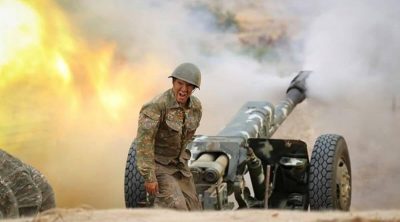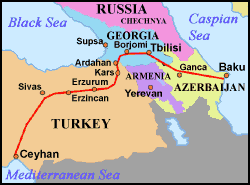Don’t Blame the Soviets for the War in Nagorno-Karabakh

In the final week of September, an Azerbaijani offensive renewed hostilities in the perennial armed conflict and territorial dispute in the South Caucasus between Armenia and its neighbor over the Nagorno-Karabakh (“Mountainous Karabakh”) region.
By October, the clashes had escalated past the state border between Azerbaijan and the internationally-unrecognized Republic of Artsakh which suffered heavy shelling from banned Israeli-made cluster bombs by the Azeris. Meanwhile, Armenia retaliated with strikes in Azerbaijan outside of the contested enclave, with civilian casualties reported on both sides in the deadliest resumption of large scale fighting since the Russian-brokered ceasefire in 1994. Following Baku’s victory recapturing the town of Shusha which had been under Artsakh control since 1992, a new armistice was signed by Azerbaijani President Ilham Aliyev, Armenian Prime Minister Nikol Pashinyan, and Russian President Vladimir Putin last month. However, what distinguished this re-ignition of the war from previous skirmishes were not just the severity but its direct instigation by Turkey with military support for Azerbaijan, which included the widely publicized recruitment of jihadist mercenaries from Syria.
Contrary to what one might assume, the boundary dispute does not date back centuries and its roots are relatively modern, despite the interrelated historical persecution of Armenians by the Turks and Ottoman Empire. As many have noted, the foundations for the war which began in 1988 were laid not in antiquity but decades prior during the establishment of the Soviet republics in the South Caucasus following the Russian Revolution. More specifically, the controversial decision by Joseph Stalin in 1921 to incorporate the region into Azerbaijan would have enormous consequences when the USSR later dissolved, as the vast majority of the population within the upland territory have historically been ethnic Armenians. While that may be partly to blame, much of the shortsighted analysis of the current flare-up has oversimplified its basis by placing sole responsibility on the political decisions made by the Soviet leadership decades ago at the expense of addressing the real reasons for the “frozen conflict” in the South Caucasus.
Vladimir Lenin once described the Russian Empire as a “prison of peoples” or a “prison house of nations” in reference to the more than 120 different nationalities colonized by the Tsarist autocracy.
Following the defeat of the Ottoman Empire in World War I and the Russian Revolution, the demographics of Transcaucasia shifted with the changes in borders increasing the overall make-up of ethnic Armenians, many of whom were displaced by the genocide. However, even a century prior Nagorno-Karabakh had still been more than 90% Armenian, despite the South Caucasus generally comprising many different ethnic communities. In the 19th century, the influence of European conceptions of nationalism resulted in the various intermingling groups of the region redefining their identities in increasingly ethno-territorial and nationalist terms. To resolve the national question, the Soviets adopted a policy which encouraged the establishment of republics and administrative borders which unfortunately did not always perfectly align with the overlapping and intermixing populations.
After the Russian Revolution, Transcaucasia was initially a unified Soviet republic consisting of Armenia, Azerbaijan and Georgia, but it soon split into three separate states. Despite promising Artsakh to Armenia and against the wishes of its population, Nagorno-Karabakh was then granted to Azerbaijan but with autonomy by the Georgian-born Stalin, then the Soviet Commissar of Nationalities.
However, it is important to recognize that in spite of this fateful decision, under the USSR for seven decades the two sides held a mostly peaceful co-existence, while Karabakh Armenians continued to champion reunification with their homeland without bloodshed. That is not to say mistakes weren’t committed by the Soviet leaders who were often at odds over the national question, but one of the signature accomplishments of socialism was greatly reducing the frequently bloody conflicts between oppressed groups which shared national spaces. It was only during the circumstances of glasnost and perestroika that the social grievances of the South Caucasus took an irredentist expression which turned violent in Nagorno-Karabakh, just as it did in Abkhazia and South Ossetia in Georgia and the North Caucasus in Chechnya.
The recolonization of Eastern Europe by foreign capital included the encouragement of secessionist and nationalist independence movements throughout the post-Soviet sphere and the South Caucasus were no exception. The template for Western hegemony over the east — based on the British founder of modern geopolitics Sir Halford Mackinder’s ‘Heartland Theory’ whose “The Geographical Pivot of History” emphasized the strategic importance of Eastern Europe — was put into practice by Zbigniew Brzezinski, National Security Advisor in the Jimmy Carter administration. While the Polish-born Brzezinski delivered the Soviet equivalent of the Vietnam War and the U.S. empire’s own ‘Great Game’ by supplying lethal arms to the Afghan mujahideen, he also established the Nationalities Working Group (NWG) tasked with inciting ethnic tensions among non-Russian groups in the Soviet orbit. After the USSR collapsed, Brzezinski and the Atlanticist coven continued to mastermind the complete resizing and balkanization of Eurasia by inciting ethno-nationalist divisions in the formely ‘captive nations’ behind the Iron Curtain even after the re-establishment of the free market.
Brzezinski’s Machiavellian strategy was crystallized in his 1997 book The Grand Chessboard: American Primacy and Its Geostrategic Prime Minister Nikol Pashinyan,ic Imperatives, which not only prophesied the easterly expansion of NATO on Russia’s borders but the resurgence of Islamism and Pan-Turkism in the post-Soviet Caucasus and Central Asia. As an intellectual disciple of Mackinder, Brzezinski drew from his ideas which first theorized the importance of pulling the oil-rich South Caucasus away from Moscow’s sphere of influence. Azerbaijan was one of the first former Soviet countries to become a Western power-base after the 1993 CIA-backed coup d’etat which ousted the democratically-elected government of Abulfaz Elchibey and brought to power Heydar Aliyev, father of the current Azeri president, who pivoted the country away from Moscow and began the Azerification of Nagorno-Karabakh. Two years later, Brzezinski visited Azerbaijan and helped arrange the Baku-Tbilisi-Ceyhan pipeline linking the Caspian Sea oil basin from Azerbaijan through Georgia to Turkey.
Since 2018, Armenia has also been in danger of becoming a Western client state after the so-called ‘Velvet Revolution’ which installed current who was supported by international financier George Soros.
Pashinyan has since pledged to sign a European Union Association Agreement but will first have to withdraw Yerevan from Russia’s Eurasian Economic Union. Following the November ceasefire agreement, Pashinyan has become the subject of widespread protests himself by Armenians, which included the storming of Yerevan’s parliament building, as many were furious over his perceived premature surrender of the strategic city of Shusha which had been under Artsakh control since the end of the first Nagorno-Karabakh war.
As it happens, Soros also gave financial impetus to the civil society group Charter 77 that led the original 1989 ‘Velvet Revolution’ which deposed the Marxist-Leninist government in Czechoslovakia.
Armenia’s 2018 ‘Color Revolution’ was identical to the many pro-Western protest movements which brought regime change in Eastern European and Central Asian countries in the post-Soviet world that was first prototyped during the fall of communism in Czechoslovakia, Poland, and the Eastern Bloc. The subsequent election of Pashinyan was supposed to reset the negotiations with Baku but instead there was a resurgence of the violence in the enclave. It is not by chance that as soon as the Armenian government began to pivot to the EU away from Moscow, a revival of clashes began. Armenians should be wary of Soros pulling the strings behind their government based on the man’s own words. Even though Turkish President Recep Tayyip Erdoğan has vilified the Open Society Foundation, the investor took out an op-ed in The Financial Times in March which whitewashed the neo-sultan while demonizing Putin.
From the Armenian perspective, it is impossible to separate the direct aid by Turkey for the Azeris during the current war from its collective memory of the genocide which Ankara and Baku deny to this day. It can only be interpreted as an existential threat and a sign of Erdoğan’s neo-Ottoman aspirations. For anyone who doubts Turkey’s expansionist ambitions, it has also been reported that Ankara has since recruited Syrian mercenaries to the Greek border and Kashmir. The exporting of foreign terrorists from Afrin and Idlib into Nagorno-Karabakh has resulted in war crimes such as the beheadings of Armenian soldiers. In the face of Azerbaijan’s reputation as the most secular country in the Muslim world, it appears the practices of Sunni Islamist headchoppers have been passed on to its nominally Shia armed forces. Turkey’s support also introduces an international dimension that presents a danger of the conflict transforming into a proxy war which threatens to draw in Israel, Iran, Russia, the U.S. and other players.
The geopolitical context of the war is not cut and dried. Ankara’s suspicion of U.S. involvement in the 2016 Turkish coup d’etat attempt and Washington’s refusal to extradite the CIA-sponsored Islamic cleric Fetullah Gülen from Pennsylvania put the US-Turkey relationship in shambles and relations were only further soured by Ankara’s purchase of the Russian S-400 missile system in defiance of its NATO commitments.
The U.S. incorporation of the Kurds into the Syrian Democratic Forces (SDF) coalition to fight Daesh pushed Turkey even closer towards Moscow’s camp. To both punish Ankara and rebuke U.S. President Donald Trump’s troop withdrawal from Northeast Syria that precipitated the Turkish invasion of Kurdish-held territory last year, the U.S. House of Representatives opportunistically passed a resolution formally recognizing the Armenian genocide after decades of refusal. However, it was dead on arrival in the Senate as Turkish and Azeri pressure groups remain a top player in foreign agent lobbying exceeded only by the exempted Zionists. At the congressional level, even “progressive” Rep. Ilhan Omar (D-MN) who has taken campaign donations from the Turkish lobby and held closed door meetings with Erdoğan notably abstained on the bill.
Some analysts intent on embellishing Turkey have suggested that because of cooling relations between the U.S. and its NATO ally in recent years, along with Armenia’s pivot to the EU, it would somehow be advantageous for Moscow to favor an Azeri victory. Even if that were true, it underestimates the historical relationship between Russia and Armenia as the protector of Orthodox Christian subjects under Ottoman rule.
In reality, the only preference for Moscow is a balancing act and diplomatic victory that will resolve what the U.S. and Turkey are instigating. Three decades after the dissolution of the USSR, Russia’s ‘near abroad’ has been almost completely absorbed into the EU and NATO which rescinded their promise not to expand past East Germany with tensions between Washington and Moscow reaching a point not seen since the height of the Cold War.
While Putin has become quite adept at negotiating compromises to national conflicts as he did in the North Caucasus ending the Chechen Wars, any new ceasefire mediated in Nagorno-Karabakh will only be a short-term bandaid on a deep-seated wound so long as the regions of the former Soviet Union remain under free enterprise and a target of imperialism which can sow dissension between its heterogenous inhabitants.
*
Note to readers: please click the share buttons above or below. Forward this article to your email lists. Crosspost on your blog site, internet forums. etc.
Max Parry is an independent journalist and geopolitical analyst. His writing has appeared widely in alternative media. He is a frequent contributor to Global Research. Max may be reached at [email protected]
Featured image is from the author



